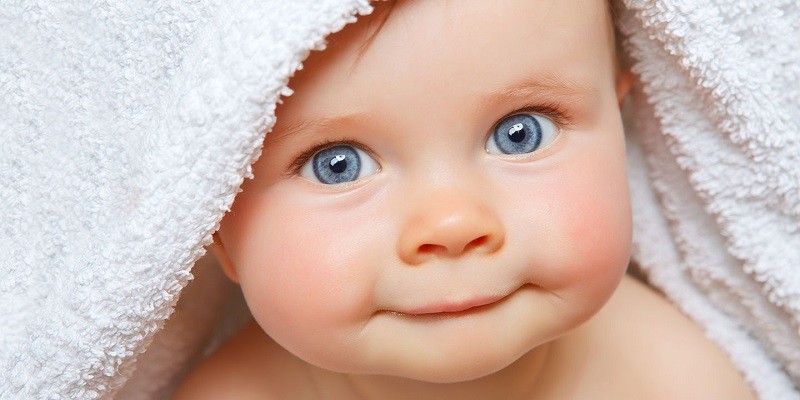Two brown-eyed parents can have a blue-eyed child if both parents have the heterozygous allele for eye color. The dominant brown eye color allele is usually responsible for determining eye color, but the recessive blue eye color allele can still be present in both parents.
Eye Color Inheritance
While brown eye color is dominant over blue eye color, it is still possible for two brown-eyed parents to have a blue-eyed child. This can occur if both parents have the heterozygous genotype for eye color inheritance.
The Role Of Genes In Determining Eye Color
Eye color inheritance is a fascinating topic, and it is primarily determined
by our genes. The color of our eyes is determined by the amount and type of
pigments in our iris, which is the colored part of the eye. The DNA in our
genes contains instructions for producing these pigments, and variations in
these genes from one person to another result in different eye colors.
The main pigment responsible for brown eyes is called melanin, while blue eyes
have less overall melanin. The presence of specific genes inherited from our parents
influences the amount and distribution of melanin in our irises, ultimately
determining the color of our eyes.
Different Variations Of Eye Color
Eye color isn’t just limited to brown and blue; there are various shades and
combinations that are possible. Brown is the most common eye color, followed
by blue, green, and hazel. The diversity of eye colors is a result of the
complex interplay between different genes and the variations within these genes.
| Eye Color | Explanation |
|---|---|
| Brown | The presence of a larger amount of melanin in the iris results in varying shades of brown, from light to dark. Brown eyes are considered dominant over other eye colors. |
| Blue | Blue eyes have low levels of melanin and appear blue due to the reflection and scattering of light within the iris. Blue eyes are considered recessive and require specific gene combinations. |
| Green | Green eyes are a result of a combination of both low levels of melanin and the presence of another pigment called lipochrome. The varying amounts of lipochrome and melanin create different shades of green eyes. |
| Hazel | Hazel eyes are a mix of brown and green, with a burst of gold or amber-like coloring around the pupil. The pigments responsible for hazel eyes are still not fully understood, but they are believed to be a combination of melanin and lipochrome. |
The Concept Of Dominance And Recessiveness
When it comes to eye color inheritance, certain genes are considered dominant while
others are recessive. Dominant genes will always be expressed, even if there is only
one copy, while recessive genes require two copies for their expression.
Brown eye color is dominant over blue eye color, which means that if one parent
has brown eyes and the other has blue eyes, there is a higher probability that
their children will have brown eyes. However, it is not impossible for two brown-eyed
parents to have a blue-eyed child. This occurrence is due to the complex nature of
genetic inheritance and the potential presence of recessive genes in both parents.
The Probability Of Blue Eyed Child
The probability of two brown-eyed parents having a blue-eyed child is possible if both parents carry the recessive blue eye gene. Although it is uncommon, genetic mutations can occur, allowing for this outcome. Eye color is determined by a combination of genes from both parents.
Exploring The Odds Of Two Brown-eyed Parents Having A Blue-eyed Child
Have you ever wondered if it’s possible for two brown-eyed parents to have a blue-eyed child? While it may seem unlikely, it is indeed possible, and we’re here to explore the fascinating world of eye color inheritance.
Factors Influencing Eye Color Inheritance
The color of your eyes is determined by the amount and distribution of a pigment called melanin in the iris of your eyes. Multiple factors come into play when it comes to eye color inheritance, including genetic mutations, dominance, and recessiveness of certain genes.
Typically, brown eye color is considered dominant over blue. This means that if one parent has brown eyes and the other has blue eyes, it’s more likely that their child will inherit brown eyes. However, there are cases where two brown-eyed parents can have a blue-eyed child.
One important factor to consider is the presence of specific gene variants known as alleles. Each parent carries two alleles for eye color, one inherited from each of their own parents. These alleles can be either dominant or recessive, influencing the eye color of their offspring.
Heterozygous Vs Homozygous Parents
When it comes to eye color inheritance, the specific combination of alleles carried by each parent plays a crucial role. If both parents are heterozygous for the brown eye color allele (Bb), meaning they have one dominant brown allele and one recessive blue allele, there is a possibility of having a blue-eyed child.
This is because for a child to have blue eyes, they must inherit two copies of the recessive blue allele (bb) – one from each parent. While each parent has a dominant brown allele (B), the presence of the recessive blue allele increases the chances of having a blue-eyed child.
On the other hand, if both parents are homozygous for the brown eye color allele (BB), meaning they have two dominant brown alleles, the probability of having a blue-eyed child is significantly reduced, as there is no recessive blue allele present to be passed down.
It’s important to remember that eye color inheritance is a complex process that can be influenced by various factors, including the presence of genetic mutations and the interaction of different alleles. While the odds of two brown-eyed parents having a blue-eyed child may be relatively low, it is still a possibility, adding to the diversity and uniqueness of human genetics.
So, the next time you come across a blue-eyed child with two brown-eyed parents, remember that it’s all part of the intricate web of genetic inheritance, where surprises and variations can always occur.
Genetic Mutations And Eye Color
It is possible for two brown-eyed parents to have a blue-eyed child due to genetic mutations. While brown eye color is dominant over blue, if both parents carry the recessive blue eye gene, there is a chance for their child to have blue eyes.
How Genetic Mutations Can Lead To Variations In Eye Color
Eye color is a fascinating aspect of genetics, and it is governed by various genetic mutations. These mutations can occur in the genes responsible for producing melanin, the pigment that gives color to our eyes. The two primary genes involved in determining eye color are OCA2 and HERC2, with HERC2 controlling the expression of OCA2.
Typically, the OCA2 gene is responsible for producing brown eyes, which is considered dominant over blue eye color. However, variations in the OCA2 gene can result in less melanin production, leading to blue or lighter eye colors. The presence of genetic mutations in both the OCA2 and HERC2 genes can contribute to the occurrence of blue eyes, even in individuals with brown-eyed parents.
The Impact Of Genetic Mutations On Eye Color Inheritance
When it comes to eye color inheritance, the process can be more complex than a simple dominant-recessive pattern. Genetic mutations play a crucial role in introducing variations and allowing for unexpected eye colors to appear in children.
If both parents carry genetic mutations in their OCA2 and HERC2 genes, it increases the likelihood of their child inheriting blue eyes. This means that even if both parents have brown eyes, they can still pass on the genetic variations responsible for blue eyes to their child.
It is worth noting that these genetic mutations do not guarantee a blue-eyed child; they only increase the chances. Other factors, such as the presence of additional genetic variations or interactions with other genes, can further influence eye color inheritance.
Exploring The Science Behind Blue-eyed Children In Brown-eyed Parents
The occurrence of a blue-eyed child in brown-eyed parents may seem perplexing, but understanding the science behind it sheds light on this phenomenon.
In a scenario where both parents carry the genetic mutations responsible for blue eyes, their child has a higher probability of inheriting those mutations and manifesting blue eyes. However, it’s essential to remember that genetics is a complex interplay of various factors, and the outcome can still vary.
To simplify the concept, it is useful to think of eye color inheritance as a combination of multiple genetic variables. The presence of genetic mutations in the OCA2 and HERC2 genes contributes to the production of less melanin, resulting in lighter eye colors such as blue or green.
So, while it may be less common for two brown-eyed parents to have a blue-eyed child due to the dominance of brown eye color, genetic mutations can disrupt the expected pattern and introduce delightful surprises.

Credit: www.buzzfeed.com
Frequently Asked Questions For Can Two Brown Eyed Parents Have A Blue Eyed Child?
How Common Is It For Two Brown-eyed Parents To Have A Blue-eyed Child?
Two brown-eyed parents can have a blue-eyed child if both parents carry the recessive gene for blue eyes.
Can A Child Have Blue Eyes If Parents Don T?
Yes, a child can have blue eyes even if their parents don’t. Both parents must carry the recessive blue eye gene for their child to have blue eyes. Eye color is determined by a combination of genes from both parents, and it is possible for the blue eye gene to be passed down even if both parents have brown eyes.
Which Parent Determines Eye Color?
Eye color is determined by a combination of genes from both parents. While brown is a dominant eye color, two brown-eyed parents can have a blue-eyed child if both carry the recessive gene for blue eyes.
What’s The Rarest Eye Color?
The rarest eye color is green, as it is estimated that only 2% of the world’s population has green eyes.
Can Two Brown-eyed Parents Have A Blue-eyed Child?
Yes, two brown-eyed parents can have a blue-eyed child if both parents carry the recessive blue-eyed gene.
What Are The Odds Of Two Dark Brown-eyed Parents Having A Child With Blue-green Eyes?
The odds depend on the genetic makeup of the parents, but if both carry the blue-green-eyed gene, it is possible for them to have a child with blue-green eyes.
Conclusion
It is indeed possible for two brown-eyed parents to have a blue-eyed child. Despite brown eye color being dominant over blue, genetic mutations can occur, resulting in blue eyes. The parents may carry the recessive blue eye gene, which can be passed on to their child.
Eye color is determined by a combination of genes from both parents, and the odds of having a blue-eyed child increase if both parents have blue eyes themselves. Therefore, the possibility of two brown-eyed parents having a blue-eyed child is not as rare as it may seem.
Last Updated on January 15, 2025 by Marjorie R. Rogers, MA (English), Certified Consultant

